
Lug 22, 2013 | The Blog
Even a land-locked country like Austria can have its own Bermuda Triangle. In Vienna’s case, we are obviously not talking about the treacherous waters off the US Atlantic coast, nor is there – as far as I know – any paranormal activity involved.
The Austrian capital’s Bermuda Triangle (or Bermudadreieck in German) is not even shaped like one. It’s a section of prime real estate in the historical heart of Vienna. The St. Rupert Church (Ruprechtskirche) acts as its main landmark and this area is roughly located between the square known as Hohenmarkt (with its signature gilded Anker clock and one of Vienna’s most popular würstel stands) and the Schwedenplatz, with the adjoining Danube Canal.
This is Vienna’s elegant First District, which at one time contained the Jewish Quarter and still is home to the city’s main synagogue. In earlier times this was the location of the Roman military camp of Vindobona. St Stephen’s cathedral lies within a short walking distance (less than 10 minutes) and so do a number of celebrated Viennese sights.
More than a physical place, the Bermuda Triangle is a state of mind. This part of the city is synonymous with nightlife: lively restaurants and watering holes abound, both within its imaginary boundaries and in the adjoining streets of the city center. In recent years, the concept and atmosphere of the Triangle have progressively pervaded the neighboring area lying between the Judengasse and Rudolf Square to the north-west.
The evocative nickname dates back to some 30 years ago, when a smattering of bars, music clubs and restaurants opened in this area almost at the same time, and serious bar-crawlers started “disappearing” into them for hours on end. Unlike the sailors and fliers lost in the “real” Bermuda Triangle, the revelers would eventually head home at closing time, with scant recollections of what they had been up to and where.
If you visit Vienna’s Bermuda Triangle (and I strongly recommend you do), the classic bars and restaurants worth checking out are Roter Engel (Red Angel), Krah-Krah, Ma Pitom, Salzamt, and Philosoph, to name just a handful.
One more thing. What in Germany is called a Kneipe (roughly equivalent to a bar or p ub), in Austria takes the name of Beisl (pronounced bye-zul). Don’t go and cause a diplomatic incident on your first night out!
ub), in Austria takes the name of Beisl (pronounced bye-zul). Don’t go and cause a diplomatic incident on your first night out!
When I first moved to Vienna, my German – which I had studied in Heidelberg – was definitely Hochdeutsch (the formal version of the language) and I kept drawing suspicious stares from the locals until I mastered the Viennese vernacular and the Austrian vowel sounds. Several times in those early days I was asked if I was a “Piefke”, not exactly a term of endearment that Austrians reserve for Germans (Bavarians excluded).

Giu 8, 2013 | The Blog
I’ve just finished laboring through Dan Brown’s “Inferno”, a badly written story so replete with clichés it feels like a Lego set of banalities. But it’s got all the right backdrops – including Florence’s cobbled roads, Venice’s canals, and Istanbul’s exotic skyline – and an unlikely cast of characters, first and foremost the hero of previous Brown novels, American professor Robert Langdon, whose knowledge of symbology has ensured his tenure as the author’s go-to guy for all things arcane.
A new entry is Sienna Brooks, an intriguing heroine who will tag along beside Langdon throughout the story.
Their depth of character is so insubstantial, they could be starring in a videogame, but the key to Brown’s success lies in the devilishly (oops…) complex plots he creates, not in his writing ability.
All of his supporting characters are no deeper than those that populated vintage James Bond books, mere sketches that readers can flesh out with their own set of stereotypes.
I suspect it’ll prove difficult to tell the eventual script of “Inferno – The Movie” from the book itself.
One could also argue that Brown’s grasp of history is barely adequate to graft a mystery thriller onto well-documented historical events. In Chapter 68 he even says of Venice that the plague “weakened it enough for it to be conquered by the Ottomans”, but in reality Venice was never subjugated by the Ottoman Empire, a fact that neither he nor his researcher were obviously aware of.
Add an excessive amount of Italian dialogue – more than enough to fill a small phrase book -and you have an indifferent read with far too many flashbacks to “The Da Vinci Code”.
This, of course, won’t prevent it from becoming a blockbuster in bookstores and movie theaters alike.
The amount of hype that surrounded its release was professionally orchestrated and even included a free e-book sneak preview. “Inferno” was simultaneously released in mid-May 2013 in English and twelve more languages. It’s been reported that twelve translators worked in great secrecy between February and April to complete the work by the same deadline.
As a translator myself, I think the hardest part of their job must have been to render Brown’s signature shallowness into their respective languages.
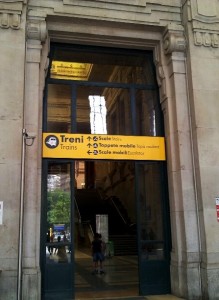
Giu 1, 2013 | The Blog
Se in Italia è caratteristico l’impiego di un tono ampolloso e poco chiaro nell’informazione diretta a cittadini e utenti (e ne abbiamo parlato qualche anno fa nel post Severamente ridicolo), l’apoteosi dell’imbecillità è spesso raggiunta dai messaggi emessi dalle ferrovie.
Quella dell’autoferrotranviere non è tradizionalmente una carriera prescelta dai grandi comunicatori, come anche è possibile affermare che le grandi menti di questo Paese non abbiano fatto il concorso alle poste o in dogana.
Il ferroviere (anche quello che non guida il treno e non ha il fischietto) sceglie un linguaggio vago e al tempo stesso stantio, un registro formale che assicura la scarsa comprensibilità del messaggio. Chiunque osservi per cinque minuti l’andirivieni umano in una stazione si renderà conto di quanto eterogenea sia la popolazione dei passeggeri e quanto essenziali siano quindi la chiarezza e la semplicità degli annunci (se l’obiettivo è veramente quello di fornire informazioni utili).
Ecco pertanto che una voce computerizzata che invita a “disporsi sul marciapiede in relazione alla posizione della carrozza corrispondente al livello di servizio acquistato” rischia di non essere compresa dai più, rivelandosi del tutto inadatta a informare.
Se si voleva invitare i passeggeri a posizionarsi in corrispondenza della loro carrozza, si poteva fare di meglio.
Considerato che molti dei passeggeri sono in grado di navigare su Internet e stamparsi un biglietto (e molti altri riescono a far funzionare la assurde macchinette automatiche che emettono i biglietti), sarebbe anche legittimo credere che essi abbiano – già da tempo e da soli – compreso i vantaggi di prevedere dove si fermeranno le carrozze di prima e di seconda classe. Gli altri, quelli irreparabilmente stupidi, trarranno poco giovamento dalle indicazioni dell’annuncio misterioso blaterato attraverso gli altoparlanti.
La stessa voce sintetizzata invita anche, a intervalli regolari, a non salire o scendere da treni che non siano completamente fermi. Peccato che ormai le chiusure centralizzate delle porte impediscono comunque di farlo.
Non parliamo poi delle traduzioni in altre lingue di annunci che, già in italiano, non brillano per chiarezza e intelligenza. Un cartello adesivo che appare nelle carrozze ferroviarie descrive con dovizia di particolari e illustrazioni tecniche il da farsi qualora si sia costretti a evacuare il treno in una galleria. 
A parte l’evidente assurdità di stampare una procedura complicata che nessuno leggerà in caso di emergenza, anche l’uso di exodus per tradurre esodo in inglese la dice lunga. Le alternative (exit, egress, escape) sembravano troppo banali al traduttore e al supervisore delle traduzioni (ammesso che ce ne sia stato uno). Nel dubbio, complicare!
Un altro fiore nello stupidario ferroviario ce lo offre la stazione di Milano Centrale, dove ormai da anni fervono faraonici lavori di ammodernamento, che affiancano futuristiche scale mobili a un bazar terzomondista di venditori ambulanti, vagabondi e ubriachi.
A livello strada, alcuni cartelli indicano e traducono in inglese le varie modalità di salita al piano dei binari. Vediamo quindi Scale Mobili/Escalator, Ascensori/Lifts e un prezioso Tappeto Mobile/Tapis Roulant. Ma qualche ferroviere linguista si è accorto del fatto che tapis roulant è francese?
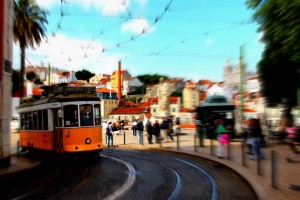
Mag 29, 2013 | The Blog
Milan and Lisbon – two very different cities – share at least one common trait: they both operate vintage streetcars as part of their regular public transit system. While distinctive and generally admired, Milan’s trams haven’t been adequately promoted by the transit company (ATM) and the city administrators. A missed opportunity for sure, if you think of the iconic status achieved by London’s double deckers, which are ultimately nothing but diesel-powered buses with very little character.
In Lisbon, instead, tram route No. 28 has deservedly become an icon, but several more lines are still in operation and feature the same rolling stock. Their diminutive single-truck streetcars (locally known as eléctricos) are each rated for a maximum of 58 passengers, 38 seated and 20 standing, but when they were designed (in the early 1900s) people were smaller — and they certainly did not carry backpacks.

Eléctricos are roughly half the size of a Milan double-truck streetcar but look remarkably alike, even down to the white-over-yellow livery. You’ll find them incredibly packed and uncomfortable, but the noisy, jerky ride is great fun and offers priceless glimpses of old Lisbon.
You’ll see signs warning passengers against pickpockets, a rather real hazard in those confined spaces, so make sure your valuables are stored in a safe place. You can board the eastbound tram of route No. 28 in the old town, at Rua da Conceição corner of Rua da Madalena, but chances are you’ll have to wait for the next car as the first one that comes along may be already full.
Your streetcar will eventually wind its way uphill on its narrow-gauge tracks zooming past pedestrians and barely missing balconies and brick walls. The stop at Largo Santa Luzia is next to a great overlook (miradouro) offering panoramic views on the old town and the Tagus river. From there you can also climb to the Moorish Castelo de São Jorge. Further up, the route will stop at the Monastery of São Vicente de Fora, from which you can walk to the Feira da Ladra fleamarket and the huge domed church known as the National Pantheon..
The first tram service in Milan was rolled out in 1876, with horse-drawn cars carrying passengers to nearby Monza, 16 kms (10 miles) away. Seventeen years later, the electrification process of the tramway network began and was eventually completed in 1901, the same year in which Lisbon’s streetcars were electrified! The Italian city’s trams in their yellow – and later green – livery became a very familiar sight and their operation was never interrupted to this day.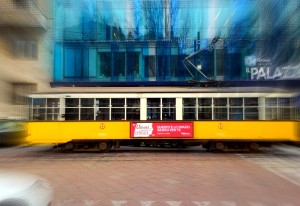
At the time of maximum expansion of the Milan streetcar network, some 500 vehicles of the latest type (Model “Ventotto”, or Twenty-eight) had been built. Of these, 200 are still in operation.
These streetcars were modeled after the US-built Peter Witt cars and looked strikingly similar to the vintage New Orleans trams that inspired Tennessee Williams’ famous play A Streetcar Named Desire (Desire being the actual name of a New Orleans urban railway line).
Milan’s transit company has been selling many of the mothballed surplus cars to its counterparts in various parts of the world. The city of San Francisco operates eleven Ventottos, some of which have even retained the original white-over-yellow color scheme. More cars have been bought by an American manufacturer that has built replica cars on the original wheel trucks and sold them to the city of Charlotte, in North Carolina, to operate a heritage streetcar line, the Charlotte Trolley. As is the case both in Milan and Lisbon, this heritage line is part and parcel of the city transit system and not a separate attraction.
A regular public transit ticket is all you need to ride a Twenty-eight streetcar in Milan and sit on its benches of varnished wood while it clangs and rumbles through the city streets. You can board one of these historic streetcars next to the main rail station (Milano Centrale): Lines 5 and 33 stop in Piazza IV Novembre (NW side of the station) and Line 1 can be boarded in Via Settembrini (corner of Via Scarlatti) on the SE side of the station. I would recommend the latter for a nostalgia ride through the city center. The one-way journey to Corso Sempione will take around 40 minutes on a total distance of 6,000 meters (4 miles) and 19 stops. Once you get off the streetcar at the Arco della Pace stop, you may choose to walk through Sempione Park all the way to the Sforzesco Castle and reach the Duomo in about half an hour.
You don’t have to be a tram aficionado to enjoy riding these old cars – whether in Milan or Lisbon – and your experience will be pretty much the same as it would have been a hundred years ago. Where else would you get such an opportunity for virtually no money at all?
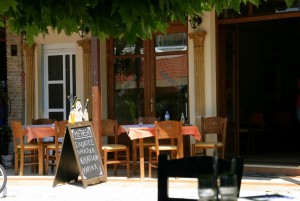
Apr 20, 2013 | The Blog
 The old Greek gent wearing a fisherman’s cap looked up and nodded when my girlfriend and I walked into the taverna and sat at a table not far from his. I nodded back and said kalispera in my barely passable Greek.
The old Greek gent wearing a fisherman’s cap looked up and nodded when my girlfriend and I walked into the taverna and sat at a table not far from his. I nodded back and said kalispera in my barely passable Greek.
We were in Itea, a sleepy little seaport on the Gulf of Corinth, and the year was 1977. We were on a low-budget car tour of Greece and this place was ideal for us. No nightlife, no luxury hotels, just a nice beach, a couple of tavernas and some no-frills accommodation.
We ordered the standard Greek fare of souvlakia and salad, with two large beers to quench our thirst, and started chattering in Italian about the day’s events. By the time the skewered cubes of meat were served, our beers were at half-mast. The young waiter promptly brought us two more, which we actually hadn’t yet ordered.
When I looked at him quizzically, he pointed at the old Greek fellow and said: “The beers are paid for by the Kapetanios.” I mulled this over for a few seconds, then I told my girlfriend I’d be right back. I walked over to the older gent with my fresh mug of beer and sat at his table. “Kalispera, Kapetanie – I said – let me thank you for the beers. That was very kind of you”.
 He looked relieved that I knew some Greek and a slow smile crinkled up his weathered face, then he spoke.
He looked relieved that I knew some Greek and a slow smile crinkled up his weathered face, then he spoke.
“I want to tell you a war story. In 1942 this area had been under Italian control for some time. One day, as I was mooring my fishing boat at the jetty, this Italian NCO walked up to me and told me the Germans would take over control of Itea the following day and replace the Italian troops. I’d already met this soldier several times before, because he would often buy my catch for his platoon, so we were on friendly terms.
“But this time he told me he was well aware I had arms and ammunition stored in my cellar and that the Germans would put me in front of a firing squad for that. So he shook my hand as he was leaving and told me to do something about my arms cache.
“I worked through the night and, in the morning – when the Germans rolled in preceded by their sidecar motorbikes – I was clean as a whistle. But I heard that other people collaborating with the Greek resistance had been summarily rounded up and shot.”
By this time I was totally speechless at the drama that was being recounted. But the Kapetanios pressed on.
“So you see, young man, for the past thirty-five years, every time I came across an Italian I always bought him a drink”.
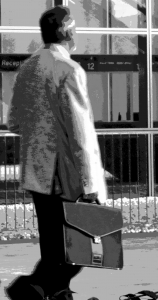
Mar 16, 2013 | The Blog
 In the temporary office the Organization always arranged for him whenever he visited Headquarters, Mike (not his real name, but it will have to do) poured himself an inch of single-malt whisky and looked through a rain-streaked window at the sprawling metropolis below.
In the temporary office the Organization always arranged for him whenever he visited Headquarters, Mike (not his real name, but it will have to do) poured himself an inch of single-malt whisky and looked through a rain-streaked window at the sprawling metropolis below.
The CEO’s resignation had caught most of the top guys unaware. That really came out of left field – thought Mike – and gave him and most of the key executives very little time to jockey for the best position in the inevitable race for the succession of the Organization’s top job.
40 years in and counting, Mike had seen a lot of comings and goings in the hallways of power. He had been patient and laid back, but always politically alert and keenly aware of the shifting winds in the Organization’s executive floors.
This time – he felt – he could have been in the pole position, had he had enough time to rally support and flex his muscles. But the situation had evolved too rapidly, leaving him no option but to ride it out. He’d barely managed to grab the last first-class seat on the overseas flight to Headquarters. His Executive Assistant had not been so lucky. He’d had to settle for a seat in coach just to travel on the same plane. A hulking 260-lb former quarterback, he had shoehorned himself into seat 39E (the middle one in a row of 5) of the eastbound Boeing 777 and had endured a most uncomfortable ride.
Mike was a seasoned fighter. He had survived the scandals and the global rage at some of the Organizations wrongdoings, and the spate of class actions that had rocked one of the world’s most asset-rich institutions while taking a big bite out of its bottom line.
“This time – he said out loud – I really thought I could make it to the top”.
But the shake-up that followed the boss’s departure had produced a dark horse, someone who many thought wasn’t even in the race, and – before most of the CEO hopefuls had had time to realize it – the long-shot contender was installed and had even given his first press conference.
Mike drained the last drop of mellow liquor from the heavy crystal tumbler, carefully placed it on the antique desk and picked up his leather briefcase to leave. He closed the door and dropped the keys at reception. His flight home would leave in just over 2 hours.
Outside, the rain had stopped and the air smelled of wet leaves. A black, late-model Mercedes was idling at the curb and a doorman was placing his suitcase in the trunk. Before sliding onto the back seat, Mike looked up at the majestic historical building that housed the Organization, his sole employer for over four decades. He shook his head ruefully and got inside the car.
At the main gate, the Swiss guards saluted smartly as the car eased into the city traffic leaving the Vatican behind.

 ub), in Austria takes the name of Beisl (pronounced bye-zul). Don’t go and cause a diplomatic incident on your first night out!
ub), in Austria takes the name of Beisl (pronounced bye-zul). Don’t go and cause a diplomatic incident on your first night out!











